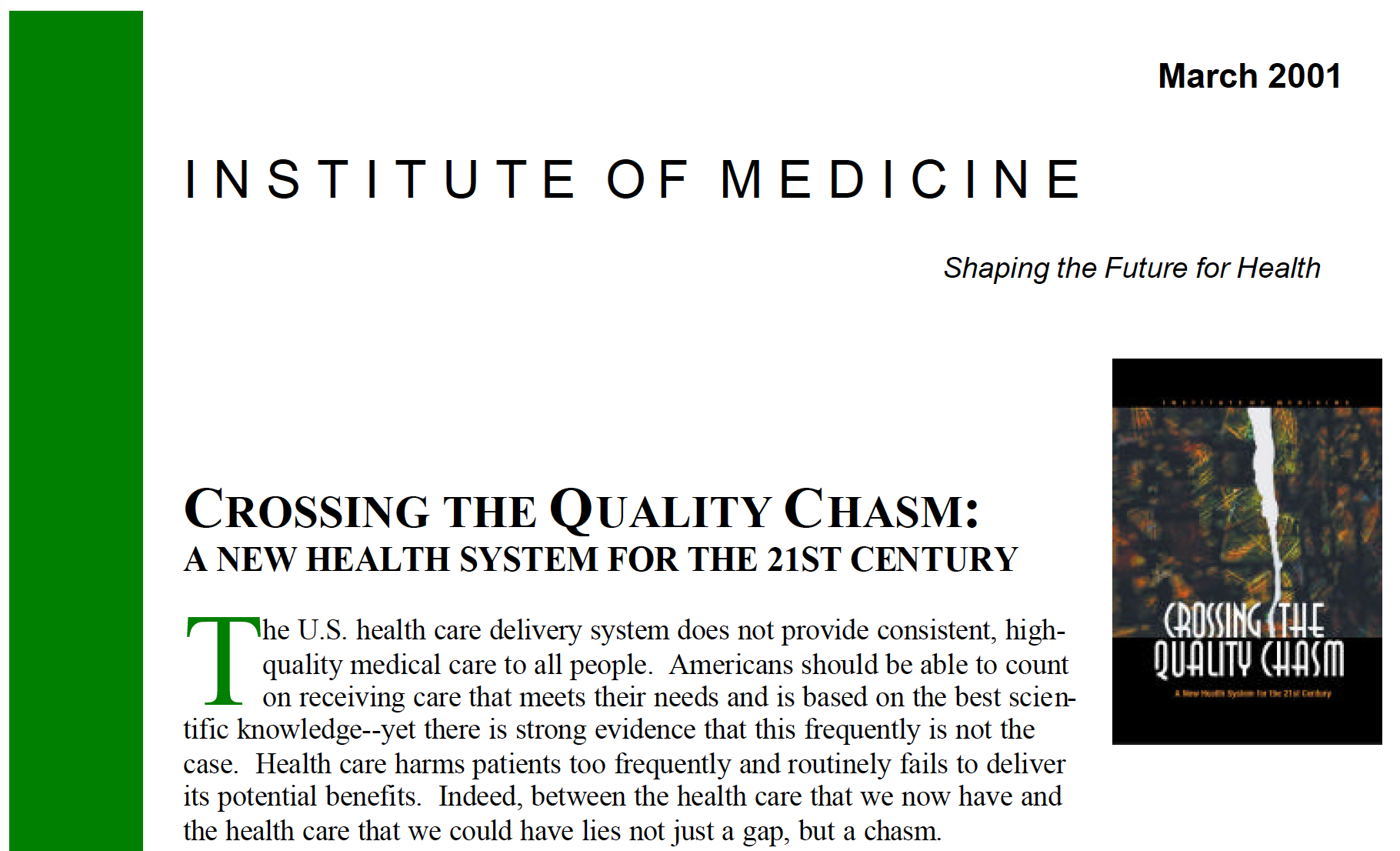Kris English, PhD
The University of Akron/NOAC
In 2001, the Institute of Medicine recommended six goals to improve health care, by taking steps to ensure that health care is:

- Safe: avoiding injuries to patients from the care that is intended to help them.
- Effective: providing services based on scientific knowledge to all who could benefit, and refraining from providing services to those not likely to benefit.
- Patient-centered: providing care that is respectful of and responsive to individual patient preferences, needs, and values, and ensuring that patient values guide all clinical decisions.
- Timely: reducing waits and sometimes harmful delays for both those who receive and those who give care.
- Efficient: avoiding waste, including waste of equipment, supplies, ideas, and energy.
- Equitable: providing care that does not vary in quality because of personal characteristics such as gender, ethnicity, geographic location, and socioeconomic status.
Patient-centeredness is especially relevant to this web forum, since it assumes a set of therapeutic skills in interpersonal communication. But although the IOM provides this working definition, the following concerns can be found in health care literature:
“Patient-centered care (PCC) is a poorly conceptualized phenomenon and can indicate anything from soothing room design, emotional support of patients, customization of meals, to support of patient decision making. This inconsistency across the clinical and research literature makes the application of PCC difficult” (Hobbs, 2009, p. 52).
“The term person-centered care (PCC) has been frequently used in the literature, but there is no consensus about its meaning” (Morgan & Yoder, 2012, p. 6).
“A clear definition is lacking” (Rathert et al., 2012, p. 351).
“The implementation of PCC has been hampered by the lack of a clear definition and method of measurement (Robinson et al., 2009, p. 600).
“We still don’t know how to do [PCC] or how to teach it” (Cassel, 2013, p. xii).
A bit alarming! However, since 1995, patient-centeredness has been expertly addressed by Stewart et al. (mostly recently in 2014), and in my humble opinion, their text serves as a gold standard: not only do they clearly and comprehensively define patient-centeredness, but they also show the reader “how to do it” and “how to teach it.”
To date, patient-centered care (PCC) has been only indirectly addressed in audiology, likely resulting in the same problems with clarity mentioned above. However, clarity is needed now more than ever, as audiology strives to elevate its relevance in health care “beyond the audiogram” and “beyond technology” by returning, as many say, “back to our roots” as fully-rounded and value-added care providers. For our patients’ sakes and for our future as a helping profession, we must commit to and effectively practice evidence-based patient-centeredness.
 This entry is the first in a 5-part series designed to compile what we know about PCC in audiology, as well as identify what we don’t know. The next four entries willl explore the concept of patient-centeredness in audiology practices, using Stewart et al.’s (2014) “interactive components” as a framework:
This entry is the first in a 5-part series designed to compile what we know about PCC in audiology, as well as identify what we don’t know. The next four entries willl explore the concept of patient-centeredness in audiology practices, using Stewart et al.’s (2014) “interactive components” as a framework:
2/5: Exploring Heath, Disease and the Illness Experience
- Unique perceptions and experience of health (meaning and aspirations)
- History, physical, lab
- Dimensions of the illness experience (feelings, ideas, effects on function and expectations)
3/5: Understanding the Whole Person
- The person (e.g., life history, personal and developmental issues)
- The proximal context (e.g., family, employment, social support)
- The distal context (e.g., cultural, community, ecosystem)
- Problems and priorities
- Goals of treatment and/or management
- Roles of patient and doctor (audiologist)
5/5: Enhancing the Patient-Clinician Relationship
- Compassion and empathy
- Power
- Healing and hope
- Self-awareness and practical wisdom
- Transference and countertransference
Each module will include an informal self-assessment, plus encouragement to connect with a like-minded colleague to discuss, test out, and grow into new patient-centered practices. A seemingly small change such as not describing the audiogram to every new patient merely out of habit tends to make us very uncomfortable. Support from colleagues can help us step out of our comfort zone.
Invitation: If the reader is interested in contributing to this topic, please send a note to the email address at the top of this page.
NEXT: Audiology Counseling and Patient-Centered Care, Part 2/5: Exploring
References:
Cassell, E.J. (2013). The nature of healing: The modern practice of medicine. New York: Oxford University Press.
Hobbs, J.L. (2009). A dimensional analysis of patient-centered care. Nursing Research, 58(1), 52-62.
Stewart, M., Brown, J.B., Weston, W.W., McWhinney, I.R., McWilliams, C.L., & Freeman, T.R. (2014). Patient centered medicine: Transforming the clinical method (3rd ed.). London: Radcliff Publishing.
